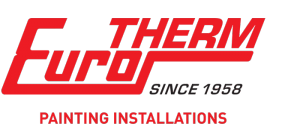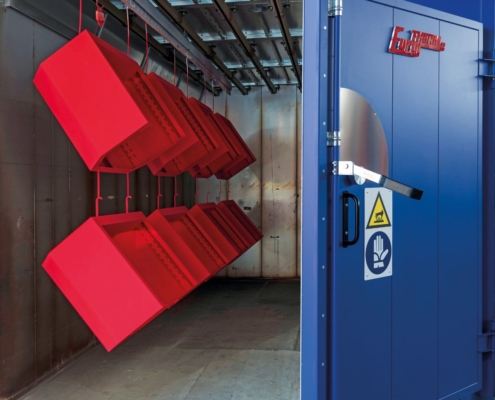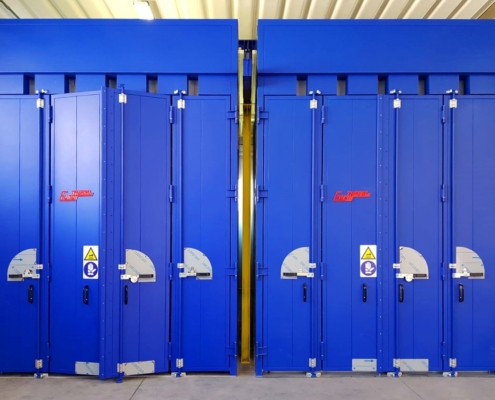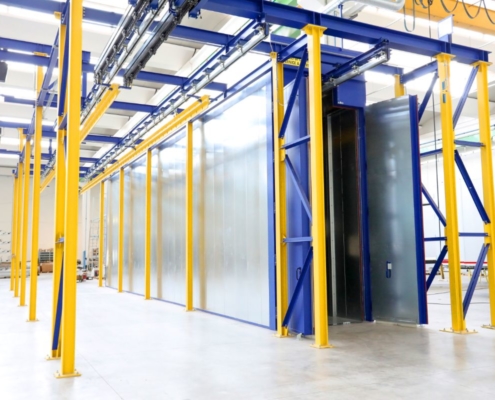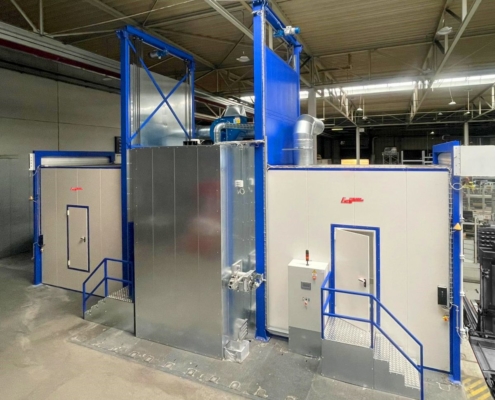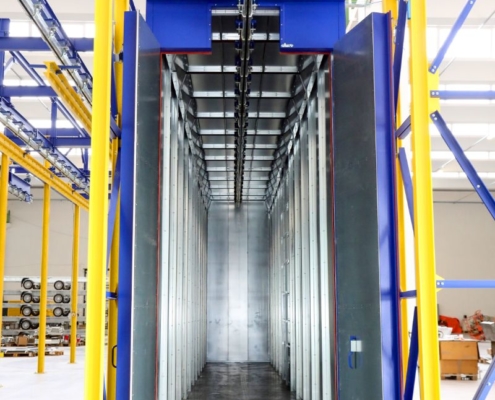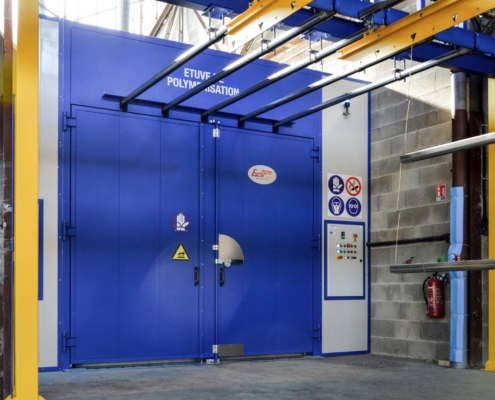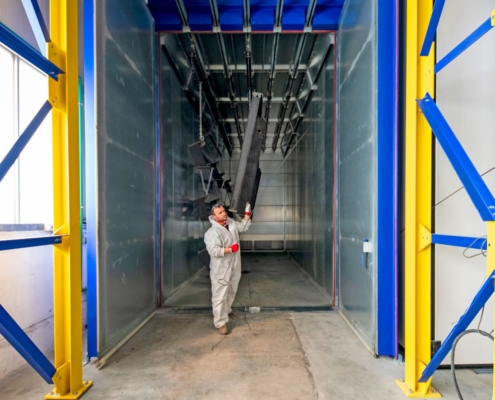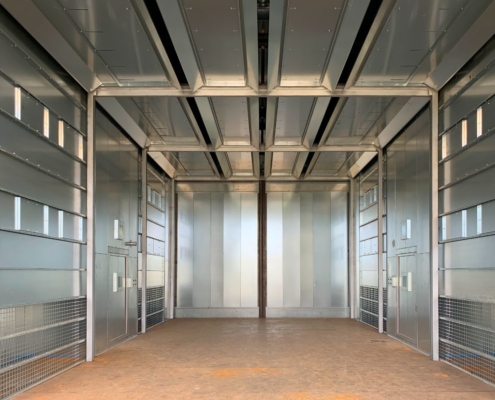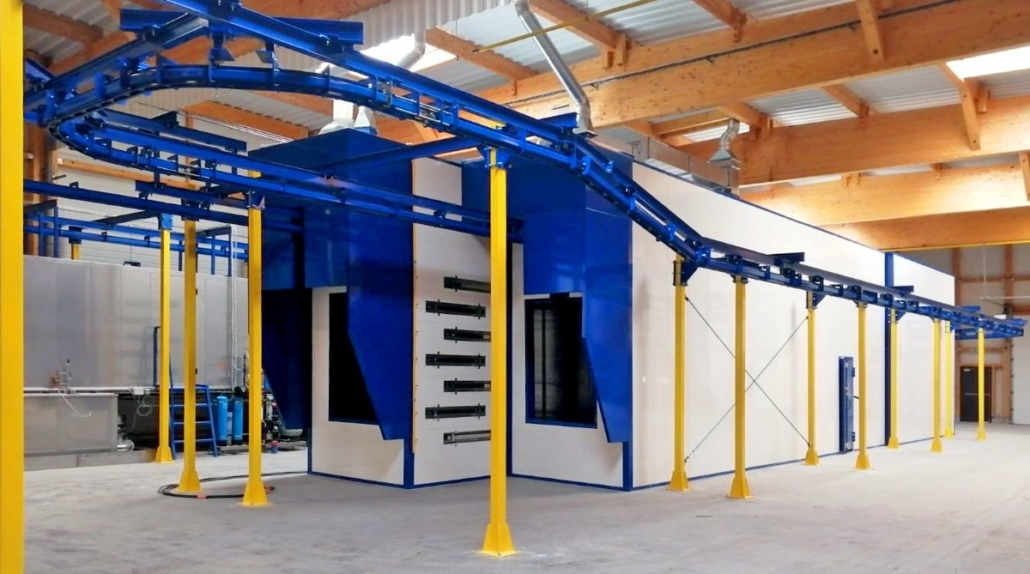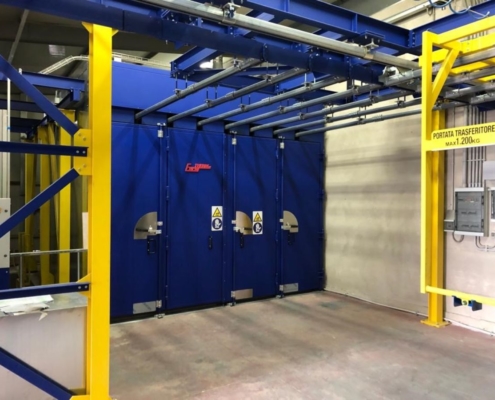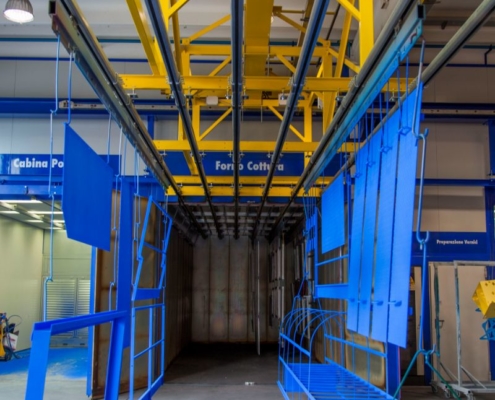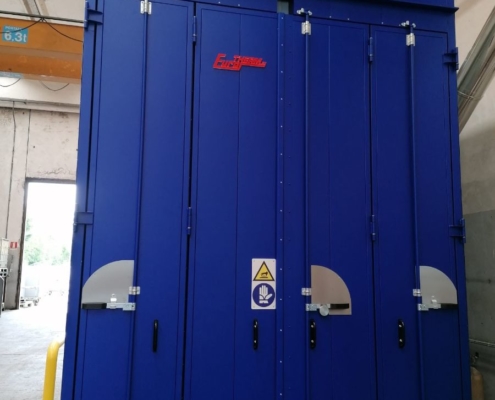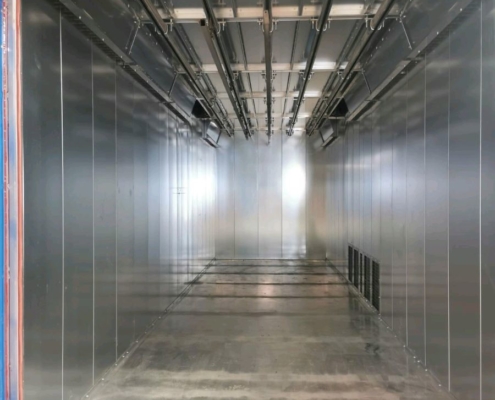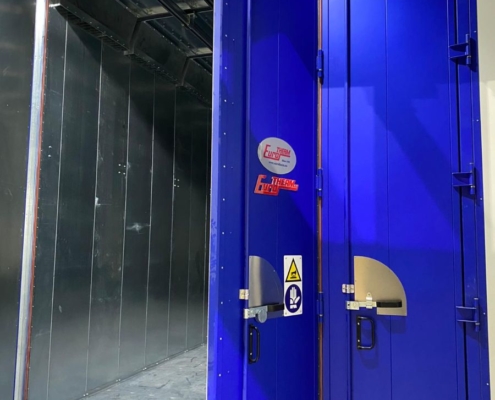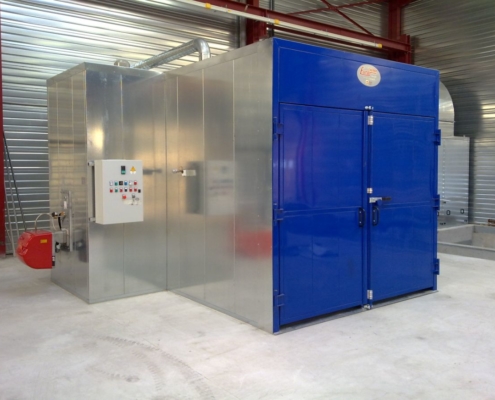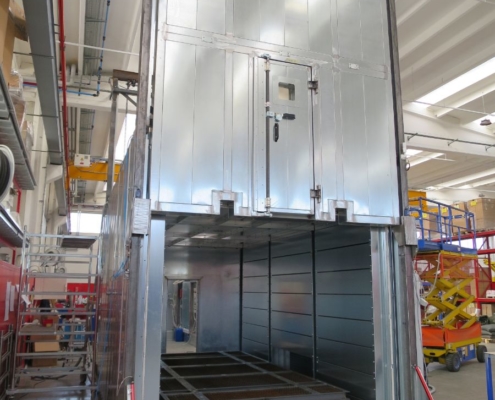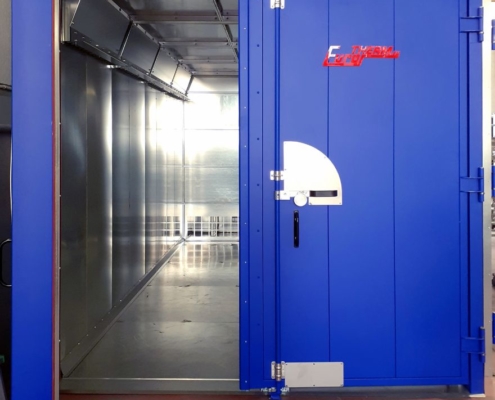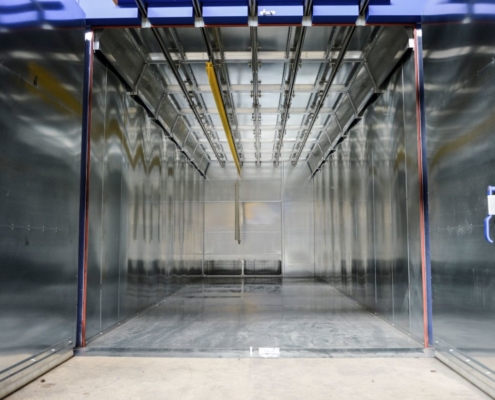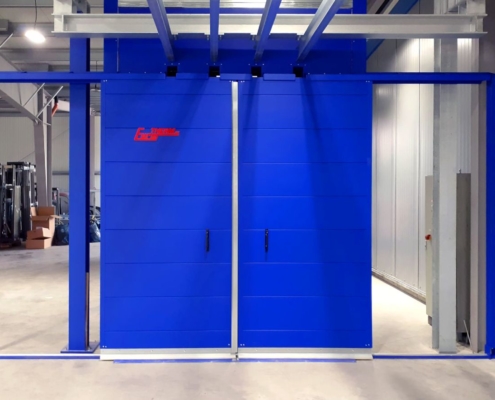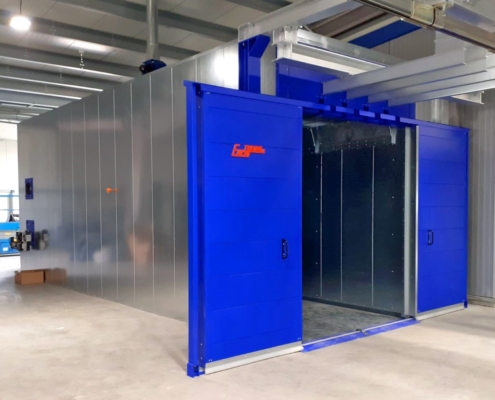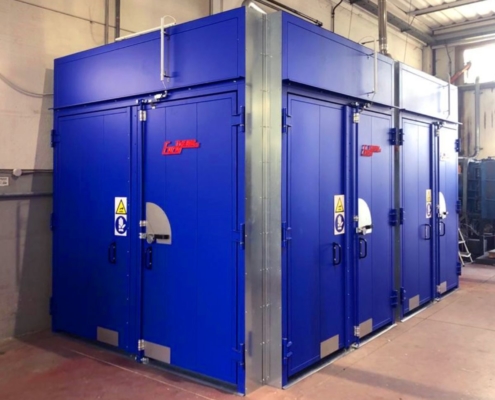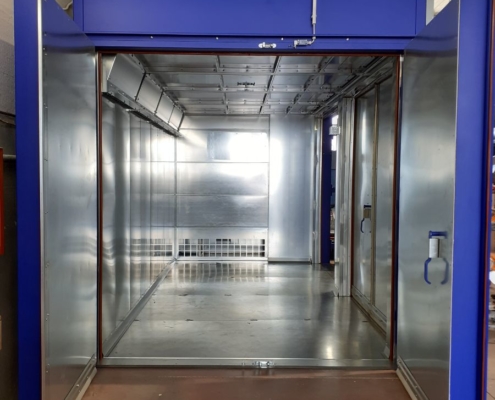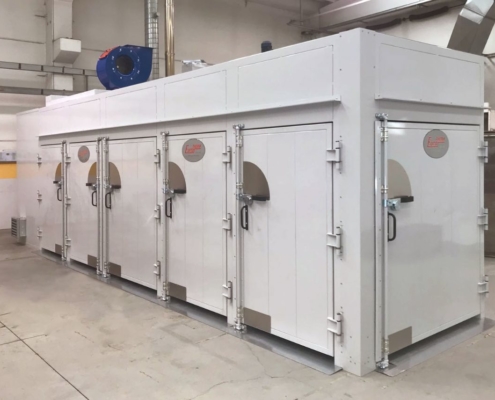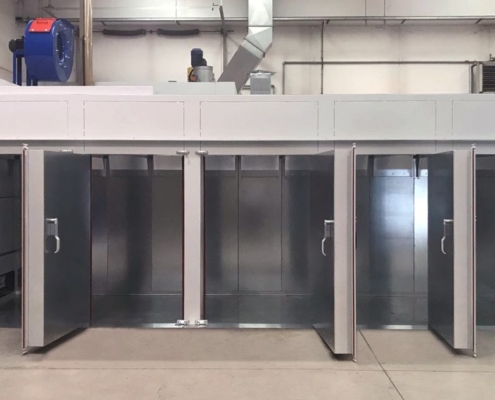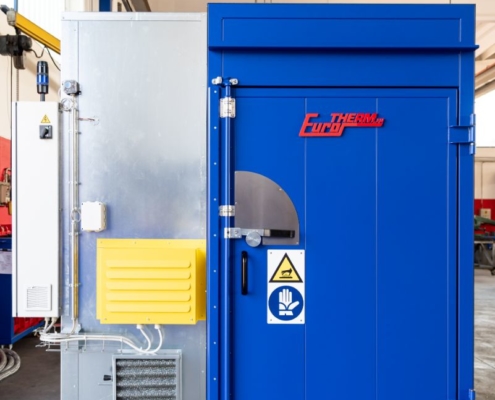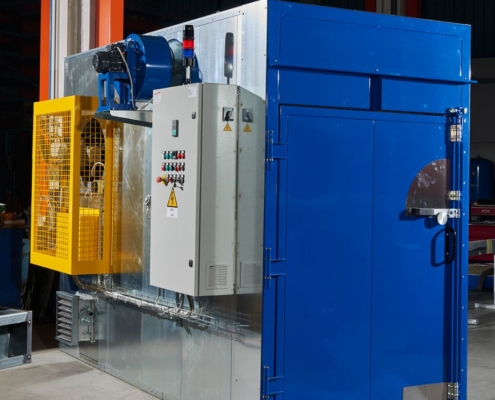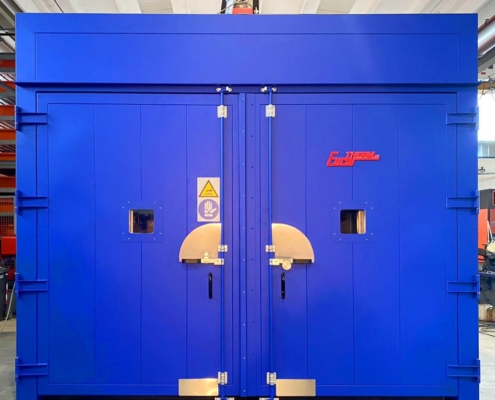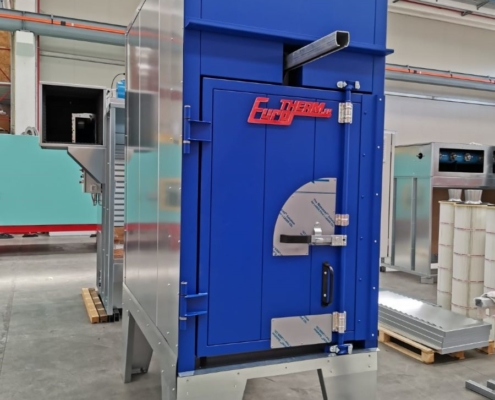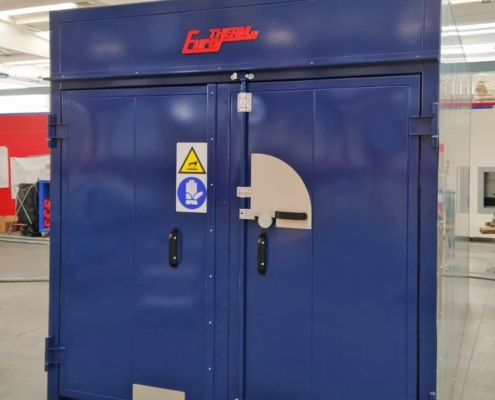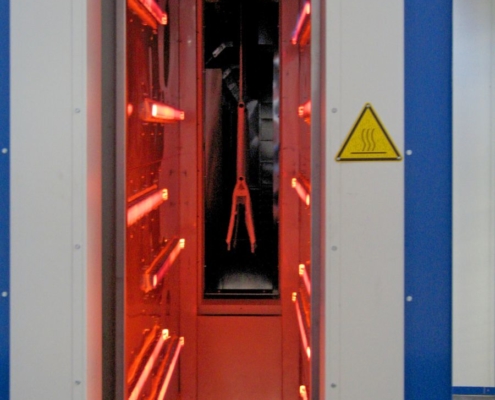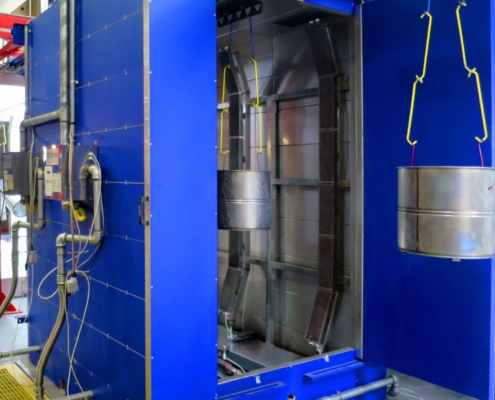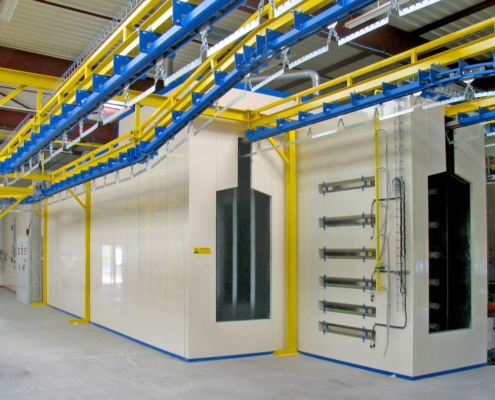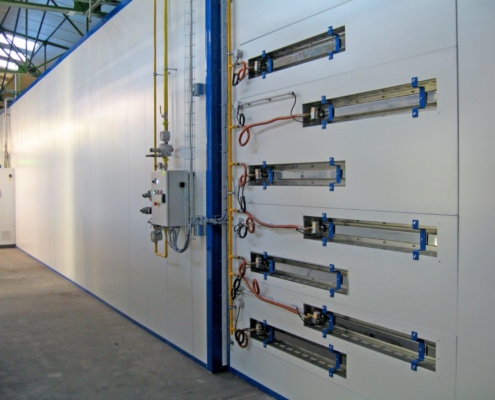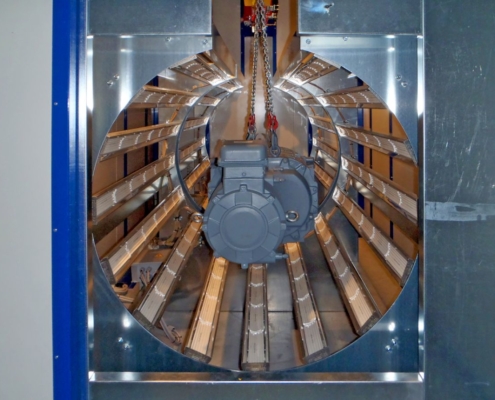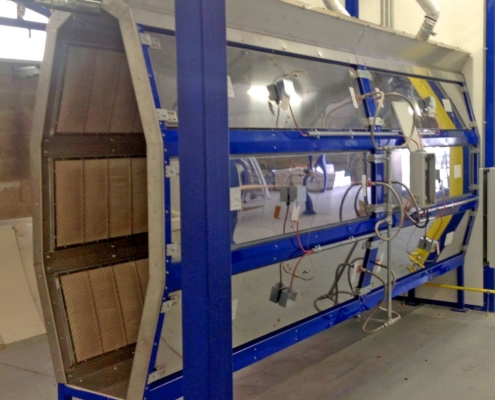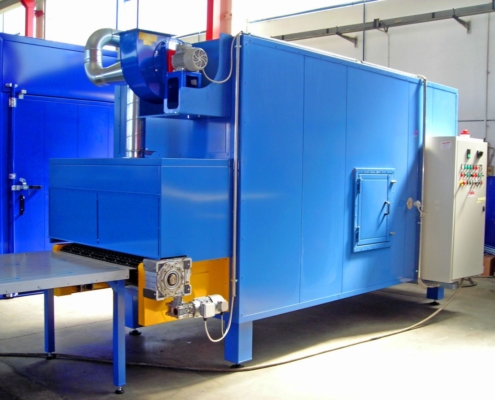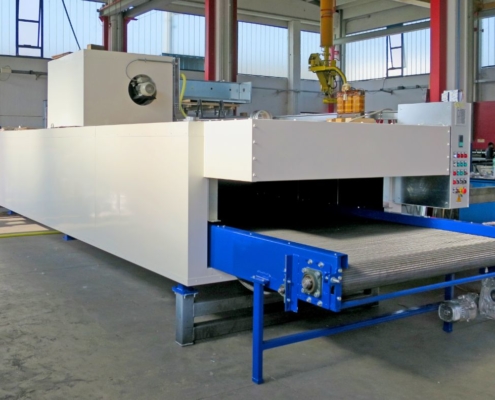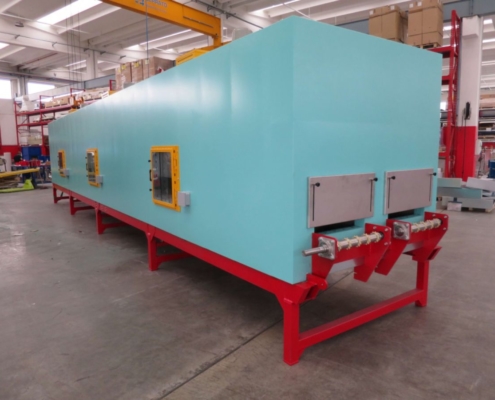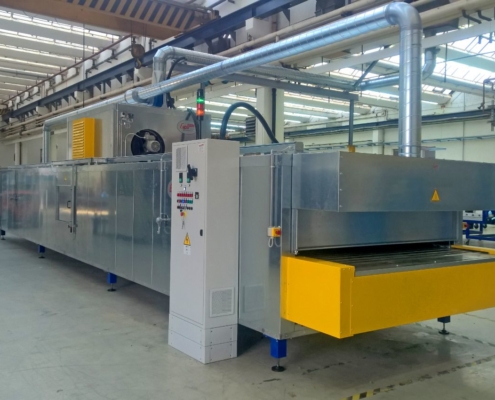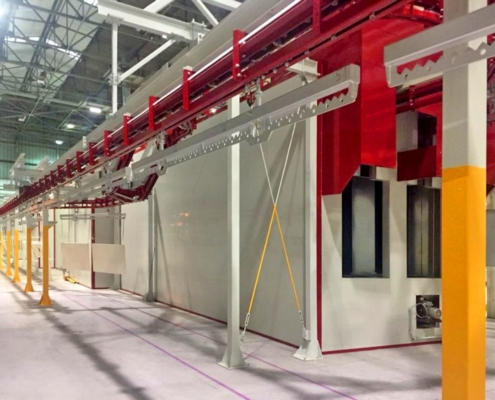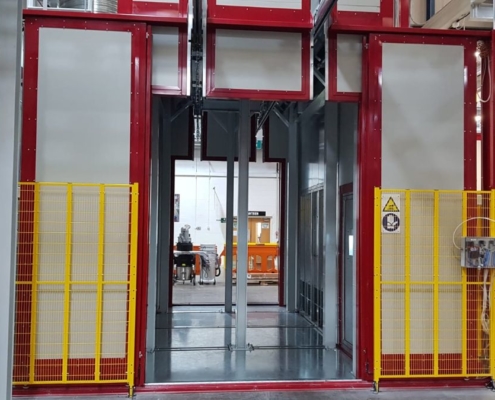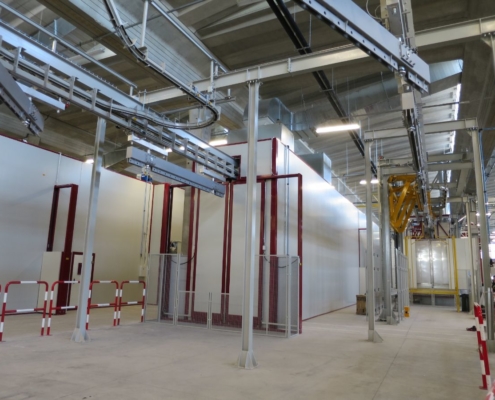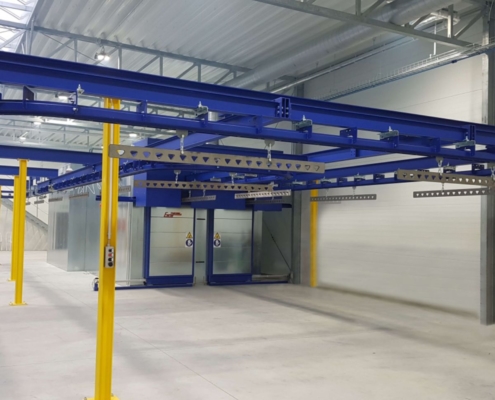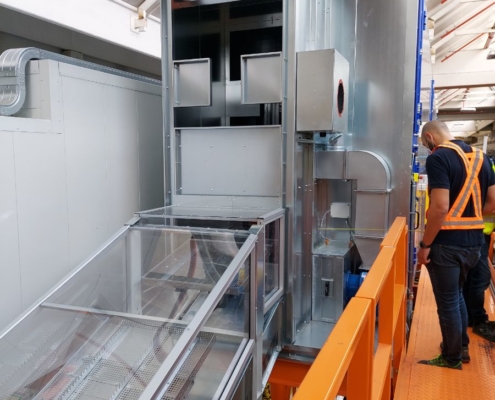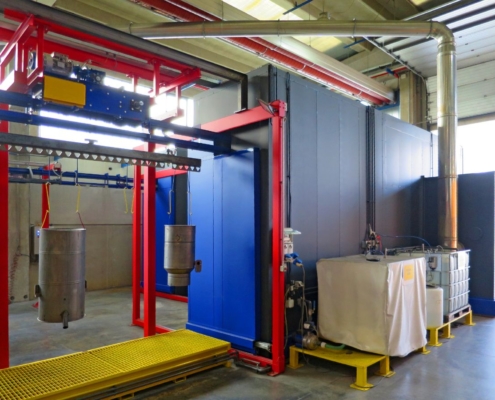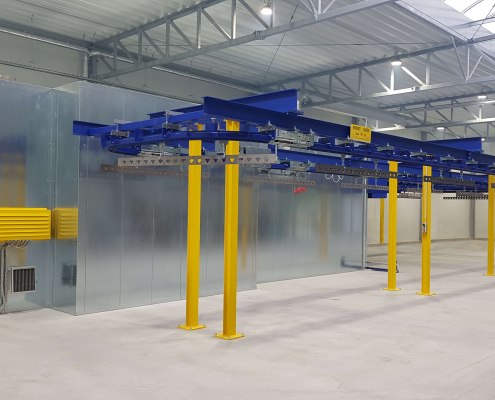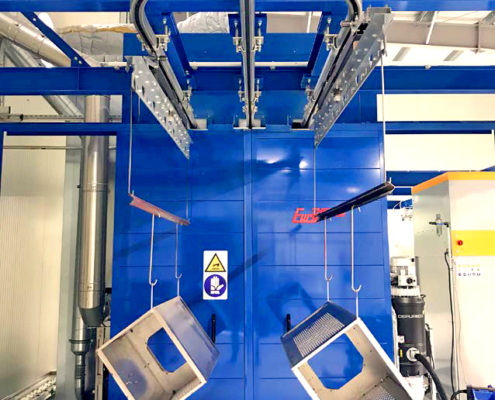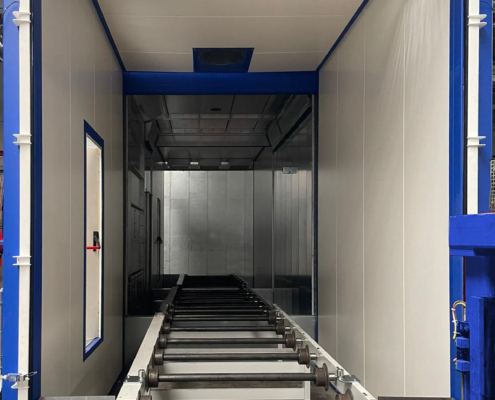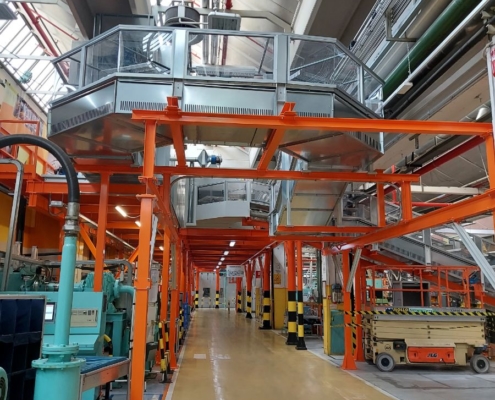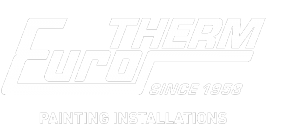- Liquid and powder coating ovens
- Customized drying and curing ovens
- 4.0 drying and curing systems
- Energy saving and heat recovery systems
- Drying oven with air stream combustion (direct exchange)
- Drying oven with combustion chamber (indirect exchange)
- Drying oven with electric heating (direct exchange)
- IR (infrared) tunnels, ovens for gelification
- Ovens with continuous belt conveyor
- Curing and drying tunnels
- Eurotherm Case Studies
- FAQs about drying and curing ovens
Eurotherm drying and curing ovens are the result of over 50 years of experience in the liquid and powder coating industry. Thanks to our high standards of performance, quality and robustness, our ovens ensure a reliable and durable functioning through the course of time.
The ovens are equipped with a heat generator that heats the air inside the chamber to the desired temperature, thus drying liquid paint or curing powder paint.
The ovens are equipped with a heat generator that can be either direct or indirect exchange, which allows the desired temperature to be reached within the curing or drying chamber. Pieces coming from other stages of processing, such as washing or painting, are fed into the oven via an overhead conveyor or other means of transport.
The temperature inside the oven is reached and maintained at a constant set point throughout the curing cycle, thanks to a temperature regulator located in the electrical panel and a temperature probe inserted inside the curing chamber. Eurotherm drying and curing ovens can reach a maximum temperature of 350°.
Our standard curing and drying ovens have a temperature range of + or – 5°C. For the aeronautic industry or other critical application areas we can narrow the range down to + or – 2°C.
Liquid and powder coating ovens
Depending on their intended use, drying or curing ovens can be divided into two main categories:
- Liquid coating ovens (or drying/de-solvation ovens)
Such ovens normally handle temperatures between 60°C and 120°C. Their function is to dry paint, generally water- or solvent-based.
- Powder curing ovens (or curing ovens)
These ovens reach temperatures of up to 250°C and are built in order to retain temperature for longer and thus avoid heat loss.
The oven is made of thick sheet metal panels sealed together with a 150mm mineral wool inner lining.
- Ovens for special treatments
Static curing ovens can also concern other special treatments. Eurotherm manufactures, for example, ovens that are employed in the aeronautical and automotive industry, as well as other special uses, such as ovens for detensioning headlights, ovens for industries that build electrical resistances, ovens for aging aluminum and so on.
Customized drying and curing ovens
Eurotherm manufactures custom drying and curing ovens in order to solve any problem related to drying and curing objects of any size.
Our ovens are designed and built according to your actual dimensional, technological, process or production requirements. In fact, Eurotherm realizes curing and drying ovens that can be customized in size and shape (in case of space problems) and can have:
- 2 or 4 shutter-equipped closing portal with sliding doors,
- side doors,
- portholes with internal lighting,
- graphic recorder with several temperature probes,
- stainless steel inner chamber,
- and other features according to your specific needs.
4.0 drying and curing systems
Eurotherm technicians are at the forefront in the realization of 4.0 drying and curing plants designed to be interconnected to the production line and management software, in full compliance with the parameters required by the regulations of the Transition Plan 4.0.
Energy saving and heat recovery systems
Ovens are composed of a heat generator inside which there is a burner, generally gas-fired. The latter heats the air taken from the curing chamber through an aspirator which then feeds it back into the oven’s plenum. Here the air is mixed and introduced, from the top to the bottom, inside the treatment chamber.
In Eurotherm ovens, the hot air inside the curing chamber is constantly recirculated. This solution allows you to keep the temperature constant over time with the minimum possible energy consumption while also ensuring an even distribution of the air at the same time. Moreover, at the end of the firing cycle, in order to allow the pieces to be unloaded from the oven, an aspirator moves the hot air outside, which can be then used to feed a heat recovery unit.
The insulation of the ovens is realized with high density mineral wool, whose thickness varies from 50 to 150 mm according to the temperatures to be reached during the expected working cycle. Eurotherm’s particular construction technology without thermal bridges guarantees an effective barrier against heat dispersion as well as considerable energy saving.
Drying oven with air stream combustion (direct exchange)
In ovens with air stream combustion the burner flame is in direct contact with the air within the cooking chamber.
For this reason it is most suitable for curing powder coatings (polymerization) and water-based liquid coatings.
The main advantages of using an oven with airstream combustion are:
- Affordability of the operation.
- Speed of reaching the designated temperature.
The main sources of fuelling are methane gas, LPG and diesel.
Download the product sheet for more information or contact us for a personalized quote.
Drying oven with combustion chamber (indirect exchange)
In indirect exchange furnaces, the burner flame is insulated within the combustion chamber. Air is passed against the hot surfaces of this chamber, thus heating it indirectly.
The main advantage of using an oven with a combustion chamber is that the combustion gases from the burner do not mix with the air in the chamber. This makes it ideal for drying liquid coatings with flammable solvents. On the other hand, the operation requires 20 to 30% more energy than an airstream oven.
In this case, too, the main sources of fuelling are methane gas, LPG and diesel.
Download the product sheet for more information or contact us for a personalized quote.
Drying oven with electric heating (direct exchange)
In drying and curing ovens with electric heating, the heating element consists of a series of electrical resistances. Ovens with electric heating are generally the smallest in our range and are particularly suitable for drying or curing small pieces or reduced high quality productions.
The main advantage is that, thanks to their compactness, they are generally assembled as a single block and can therefore be easily transported and moved.
Below you can find two examples of electric mono-block ovens:
Download the product sheet for more information or contact us for a personalized quote..
IR (infrared) tunnels, ovens for gelification
Infrared tunnels are generally inserted in continuous line plants. They are mainly used to preheat the product’s surface to over 100°C in a few seconds. In this way the powder coating is pre-gelified and the workpiece is immediately ready for a second coat of paint or subsequent curing.
There are two advantages to using an IR tunnel to gel the powder:
- the reduced size of the curing oven
- the reduction of curing times, with evident savings in terms of energy management as well.
Below are two examples of IR tunnels:
Ovens with continuous belt conveyor
In conveyor drying ovens the heating is only electric and can reach a maximum temperature of 100°C. A continuous belt conveyor runs inside the oven and along its length, transporting the piece inside and along the length of the oven until the end of the process.
Continuous belt conveyor ovens cannot be used to bake paint, only to heat the parts. Some examples of uses may be drying car filters, de-tensioning headlights, and drying pad glues.
Below is an example of a conveyor oven: medical conveyor oven for diagnostic testing.
Download the product sheet for more information or contact us for a personalized quote.
Curing and drying tunnels
Drying tunnels are generally always inserted at the exit of the washing tunnels, while the curing tunnels are located at the exit of the powder or liquid painting booths.
Pieces are transported inside the tunnel by an automatic conveyor.
They can be realized in two ways:
– with a continuous system, in which the pieces pass through the oven while curing continuously without stopping;
– with a step-by-step system, in which the pieces stop through the various areas of the system. In this case, the ovens are equipped with automatic closing/opening doors.
The main difference between the two types is that continuous ovens are faster, but also larger than step-by-step ovens.
Here is an example of a drying and curing tunnel.
Our worldwide experience makes us a leader in the field of drying and curing ovens.
Eurotherm Case Studies
Over the years, Eurotherm has distinguished itself in the field of drying and curing ovens by designing custom installations of great significance.
Here are some examples of our recent work:
- Continuous oven for automotive headlights de-tensioning;
- Custom-made passage oven for the evaporation of machining oil, fully automated, with conveyor belt for the step-by-step advancement of the pieces in three steps;
- Polymerization oven with the integration of a micro gas turbine as a source of energy and heat;
- Electric firing oven with a transport system of the pieces by a step-by-step overhead conveyor
FAQs about drying and curing ovens
What are Eurotherm ovens made of?
In ovens above 120°, the outer and inner walls, the door and the generator area are all made of thick, galvanized sheet metal. Mineral fiber and high density silicate provide effective internal insulation.
Ovens below 120° are generally made of 80 to 100 mm thick mineral wool precoated panels, pre-painted and sealed together tightly.
What are the dimensions of the drying and curing ovens?
We mainly manufacture made-to-measure ovens, designed to meet any production or space requirements. Our technical team will advise you best, from design to testing.
Can the ovens manage more than one firing process?
Whether it’s heavy carpentry or thin sheets, Eurotherm furnaces can be programmed to perform different working cycles from time to time.
It is also possible to perform drying, degassing and paint firing cycles. Temperatures and times are configurable parameters.
What fields do Eurotherm ovens work for?
Mainly industrial (light and heavy carpentry), automotive, aeronautical and medical.
Are drying and curing ovens covered by warranty?
The ovens and all their components are covered by warranty as per current regulations.
Does Eurotherm also design complete workflows?
We design and build drying and curing tunnels that can be inserted in line with washing and painting to guarantee a complete and personalized workflow, according to the specific needs of the customer.
Eurotherm creates innovative solutions to meet all of your needs.
Contact us and tell us about your business for a customized quote.
